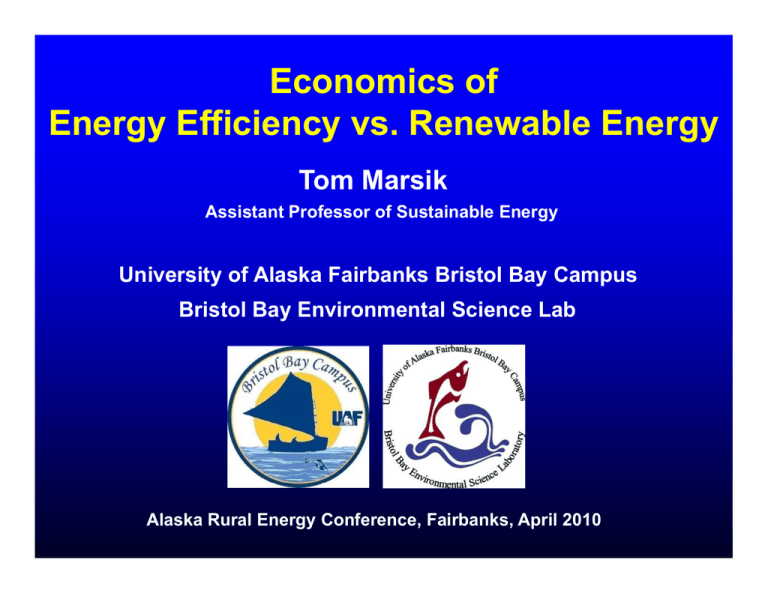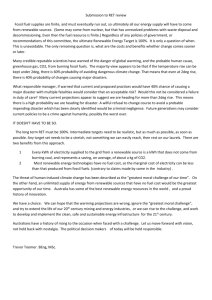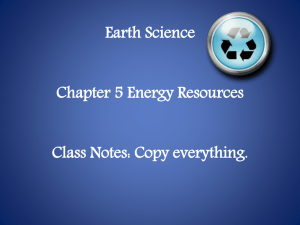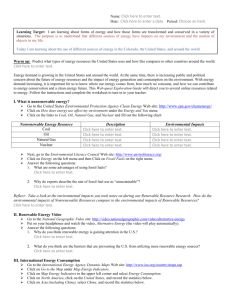Economics of ff Energy Efficiency vs. Renewable Energy Tom Marsik
advertisement

Economics of Energy Efficiency ff vs. Renewable Energy Tom Marsik Assistant Professor of Sustainable Energy University of Alaska Fairbanks Bristol Bay Campus Bristol Bay Environmental Science Lab Alaska Rural Energy Conference, Fairbanks, April 2010 Outline • Current energy problems • Energy efficiency versus renewable energy • Conclusions 2 Current energy problems Heavy use of fossil fuels and thus: • • • • Rising energy costs Unsustainable situation due to limited reserves Environmental impacts (pollution, (pollution climate change? change?, ...)) International conflicts due to US dependence on foreign sources Source: http://www.geocities.com 3 Solutions Reduce consumption of fossil fuels through: • Energy efficiency Source: www.withamymac.com • Renewable Energy Source: www.chinapage.com Consider all areas: electricity, l t i it hheat,t ttransportation t ti 4 Cost of electricity? Whi h one to Which t use to t calculate l l t payback? b k? Example – Dillingham costs in April 2010: Direct fuel cost $0.18 per kWh Direct cost to a customer (fuel cost + distributed fixed costs*) $0 34 per kWh $0.34 Total cost to society (direct + indirect**) ?$1? per kWh * Maintenance of power lines, etc. ** Clean up of oil spills, etc. 5 Energy Efficiency vs. Renewable Energy Example Incandescent bulb powered from a fossil-fuel fossil fuel power generation plant 100 W Daily energy cost @ $0.34 per kWh: 100 W x 0.001 kW/W x 24 h x $0.34/kWh = $0.82 Find the best solution to reduce fossil fuel consumption by 75%. 75% 6 Energy Efficiency vs. Renewable Energy Approach 1 – Energy efficiency: Replace the incandescent bulb with a compact fluorescent lamp (CFL) A 25 W CFL ≈ 100 W incandescent bulb reduction of 75% in fossil fuel energy and electricity cost Daily savings: 75% of $0.82 $0 82 = $0.62 $0 62 CFL cost: ~$8 $8 / $0.62 = 13 13 day payback 7 Energy Efficiency vs. Renewable Energy Approach 2 – Renewable Energy: Produce 75% of needed energy from a wind mill. Assume class 3 wind (Dillingham). Average production: A d ti 75 W Wind mill rating needed: ~400 W (wind doesn’t always blow) Daily savings: $0.62 Cost for 400 W wind mill, inverter, tower, etc.: ~$2,000 $2,000 / $0.62 = 3226 payback: 3226 days = ~9 years 8 Energy Efficiency vs. Renewable Energy Example results - summary: Fossil fuels saved Cost Payback period * With 30% tax credit Energy efficiency (CFL) Renewable energy (wind) 75 W 75 W ~$8 ~$2,000 (~$1 400*)) (~$1,400 13 days 9 years (6 years years*)) 9 Examples of energy efficiency improvement p options p Improvement Payback* Delamp in overlit areas 0 days Replace incandescent bulbs w/ CFL ~2 months Seal building envelope (weather stripping, caulking, etc.) ~6 months Install occupancy sensors in bathrooms ~1 year Upgrade T12 fluorescent lamps to T8 ~2 years I Increase attic tti iinsulation l ti from f R-20 R 20 to t R R-40 40 ~22 years Replace old refrigerator with Energy Star ~4 years Increase attic insulation from R-40 to R-60 y ~6 years Install daylight harvesting controls ~7 years Increase attic insulation from R-200 to R-220 ~100 years * Without 30% tax credit (can be used for renewable energy and certain energy efficiency improvements). 10 Cost per unit of fossil fuelss saved aannually What is the cheapest way? Desired state Renewable energy Current state Annual fossil fuel use 11 Conclusions • Energy efficiency is currently more economical than renewable energy at most places • Research and pilot projects in renewable energy are i important t t for f the th ffuture t • Ultimate solution includes both energy efficiency and d renewable bl energy 12 Questions??? ? 13








